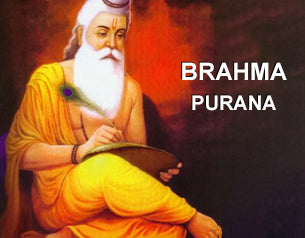The Brahma Purana is one of the eighteen noteworthy Puranas classifications of Hindu messages in the Sanskrit language. It is recorded as the main Maha-Purana in every one of the collections, and along these lines additionally called Adi Purana. Another title for this content is Saura Purana since it incorporates numerous sections identified with Surya or the Sun god. The name Brahma Purana is deceiving and spurious in light of the fact that the surviving original copies of this content have nothing to do with the Hindu god Brahma, and are in reality only an assemblage of geological Mahatmya and areas on differing subjects.
The surviving content is likely not the antiquated Brahma Purana, but rather one that was totally changed between the thirteenth to sixteenth century BCE, might many. The surviving original copies involve 245 parts. It is separated into two sections: the Purvabhaga (previous part) and the Uttarabhaga (last part). The content exists in various renditions, with huge contrasts, and the content was changed consistently after some time. Further, the Brahma Purana likely obtained various sections from other Hindu messages, for example, the Mahabharata and Puranas, for example, the Vishnu, Vayu, Samba, and Markandeya.
The content is eminent for devoting more than 60% of its parts to the depiction of topography and sacred locales of Godavari stream district, and in addition puts in and around present-day Odisha, and tributaries of Chambal waterway in Rajasthan. This movement manages like areas are non-partisan, and commends locales and sanctuaries identified with Vishnu, Shiva, Devi, and Surya. The scope of Jagannatha sanctuaries, in any case, is bigger than the other three, driving researchers to the theory that the creators of surviving original copies may have been creators having a place with Vaishnavism. Its introduction of the Konark Sun Temple is striking.
Out of 245 sections, 18 parts of the Brahma Purana cover the cosmology, folklore, lineage, manvantara, and subjects that are required to influence a content to have a place with the Puranic kind of writing. Different parts cover Sanskara, the rundown of Dharmasastra, its hypotheses on the geology of the earth, synopsis of Samkhya and Yoga speculations of Hindu rationality, and different themes. While numerous sections of the Brahma Purana laud sanctuaries and journey, parts 38-40 of the content, a piece of implanted Saura Purana, introduce contentions that are exceedingly incredulous of the mystical speculations and reverential love recommendations of thirteenth-century Madhvacharya and Dvaita Vedanta sub-school of Hindu methods of insight.
The Padma Purana classifies Brahma Purana as a Rajas Purana, suggesting the content is identified with Brahma, yet surviving compositions have nothing to do with Brahma. Researchers consider the Sattva-Rajas-Tamas characterization as "completely whimsical" and there is nothing in this content really legitimizes this arrangement.
The original copies of the movement manual for the Godavari-stream area from this Purana are found as different content and are called Gautami-mahatma or Godavari-mahatma, while the one compared to Rajasthan locale is called Brahmottara Purana. The custom and different Puranas declare the Brahma Purana had 10,000 verses, yet the surviving original copies contain in the vicinity of 7,000 and 8,000 verses selective of the Brahmottara Purana supplement which includes in the vicinity of 2,000 and 3,000 versus relying upon various renditions of similar content.
Brahma Purana
SystemAdmin GiriAustralia









